| |

Home
Thousands of tastings,
all the music,
all the rambligs
and all the fun
(hopefully!)



Whiskyfun.com
Guaranteed ad-free
copyright 2002-2024
|
 |
|
| Hi, this is one of our (almost) daily tastings. Santé! |
| |
|
| |
| |
December 8, 2024 |
|
  |
Antique Cognacs
(a slightly disrupted session) |
It’s time to conclude our little vertical tasting of high-quality vintage cognacs. So far, we’ve successfully avoided the overly standardised blends of the big brands and the borderline obscurations, and we’ve happily explored vintages ranging from 1989 to 1970 two weeks ago, then from 1961 to 1940 last week. Today, we’ll naturally have to leap over the Second World War, but not without first enjoying a pleasant little aperitif...
Every 20 to 25 years, major brands try to promote the use of their spirits in the world of cocktails, often in an effort to offset periods of declining sales. Here, Courvoisier in the 1950s offered a blend said to be perfect for a "long drink," clearly inspired by whisky, which was begining to flood into France after World War II. |
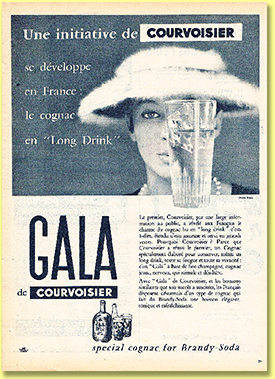 |
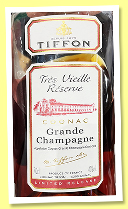
|
Tiffon ‘Très Vieille Réserve’ (43%, OB, Tiffon, Grande Champagne, +/-2024) 
We first tasted this exactly 10 years ago, and here we have a much more recent bottling. We know it’s very good. Colour: copper amber. Nose: absolutely explosive on the nose, almost like an old gewurztraminer late harvest, and let’s admit, an old pineau des Charentes. The kind of thing one would never have drunk until the good people of Cognac started letting us taste old family barrels. What a revelation, the only issue being to determine the ideal serving temperature—several schools of thought, it seems. But back to this very lovely Cognac: so, old pineau, then very old Malaga, raisins, artisanal peach liqueur, and some tertiary notes of morels, tobacco, damp earth, and liquorice. At no point do the 43% feel like a hindrance. Mouth: inevitably a little less emphatic and slightly drying, perhaps due to the ancient casks and the relatively low strength. But this blend of liquorice, pine resin, and orange liqueur works beautifully. Tobacco returns with a hint of menthol. Finish: medium in length and still slightly drying, but the flavours are spot on. A touch of leather. Comments: one dreams of three or four extra degrees of alcohol, but the overall experience is simply excellent. We’ve just discovered that the youngest Cognac in this blend is 80 years old, so there must surely be some pre-war spirit in this little gem.
SGP:551 - 88 points. |
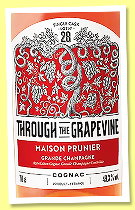
|
Maison Prunier ‘Lot 28’ (49.3%, Through the Grapevine, 7.0, Grande Champagne, 2024) 
A very old vintage, aged in roux oak (aka refill) before being transferred to a demijohn in the early 1960s. So, we can estimate roughly 35 years in wood + 60 years in glass = around 45 years by my entirely unscientific reckoning. Colour: mahogany. Nose: tar, mint, and basalt, I’d say, before adding the eternal vineyard peaches and a few touches of beeswax, old books, abbey libraries, wild mushrooms, chestnut honey, and little liquorice pastilles like those cachous we have in France. Maybe they added a few to the demijohn (just joking!). Mouth: an iron fist in a velvet glove. Honey, sweet liquorice, sultanas, and citrus marmalade upfront, but also brown tobacco, black tea, pine buds, and ground coffee in the background. The whole thing works to perfection. Finish: long, leaning more towards oak, black tea, and dark chocolate, with a touch of herbaceousness, but never becoming overly drying. Comments: two geniuses were active in the early 1960s—(Sir) Paul McCartney and the great soul who decided to transfer this admirable old Cognac to a demijohn.
SGP:561 - 90 points. |
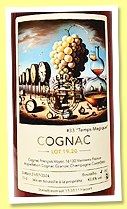
|
François Voyer ‘Temps Magique Lot 19.20’ (43.8%, Malternative Belgium, Grande Champagne, 2024) 
We’re not entirely sure how to interpret the lot number—1920? A multivintage 1919+1920? A 1919 transferred to a demijohn in 2020 and bottled in 2024? Let’s leave the mystery hanging—why must we always know everything? Colour: walnut stain. Nose: those initial puffs of pinewood suggesting very prolonged maturation in wood, then shifting to other resins (spruce, cedar) before an outright explosion of fruits, both dried and very ripe. Multiple kinds of raisins, figs, slices of pear, dates, prunes, and finally a freshly opened box of ‘deluxe’ pipe tobacco. Even if you don’t or no longer smoke, it’s worth picking up a small packet just to log the aromas in your cerebral library (right?). Of course, we’re not talking about smoking the stuff. Then, a few touches of liquorice, tar, more pine resin, turpentine, and old orange liqueur… All in all, quite a magical nose. Mouth: the wood is present, ‘of course’, but it’s very delicate and wrapped in honey, beeswax, and citrus marmalade. It’s much more compact than on the nose, but that’s often the way with very old spirits. It evolves logically towards pine bud liqueur, very dry rancio, and bitter chocolate. Finish: not many changes here; the bitter chocolate and pine resin remain firmly in control. Comments: what’s astonishing is how you feel the spirit of the times in which this marvel was distilled—so, the roaring twenties—but also other ancient beverages of the era, such as medicinal liqueurs, elixirs, and cordials. Truly a window to the past, and you almost want to put on Bix Beiderbecke or Maurice Chevalier on the old crank-driven phonograph at WF HQ. That alone earns it one extra point.
SGP:571 - 93 points. |
Well, we thought we also had three recent bottlings of much older vintages, but we got it wrong—they were the bottling numbers, not the batch/vintages. What a blunder! But instead of reimbursing you, we’d like to make it up to you with some very old bottles, if that works for you… |

|
Grande Champagne 1906 (Jacksons de Piccadilly, ‘Qualité Exceptionnelle’, 1950s) 
Bottled for the iconic London grocers, tea house, and wine merchants Jacksons of Piccadilly, whose brand was later acquired by Twinings. The mention of “The Queen” on the label and the absence of a strength indication suggest a bottling from the 1950s, likely featuring a Grande Champagne cognac of about fifty years. Probably crafted from grafted vines post-phylloxera, though not certain—Cognac retained 40,000ha of vineyards around 1906 compared to over 300,000ha in 1870 and 75,000ha today (with yields now much higher). Colour: deep gold. Nose: quite a bit of OBE, I’d say, but this old cognac starts off much drier, focused on saps and resins, before opening into grilled tones, sautéed mushrooms, and brown tobacco. One is transported to a pine forest, among moss, ferns, and fungi—you might only miss a bit of game trotting by. Mouth: the profile remains consistent, with pine sap and touches of liquorice sweets, followed by a salty brothiness and that celebrated old rancio, showing a well-matured woodiness and hints of ham. A trace of mead appears, with very little fruit, though the whole is utterly captivating. Not overly powerful but poised, holding itself admirably without any kind of decline. Finish: of medium length, a bit softer with the late arrival of some raisins that enhance the rancio. Slightly oxidative, with a persistently saline aftertaste. Comments: I must admit, I’m impressed by how well this very London-esque Grande Champagne has held up. And I do have a soft spot for pine sap.
SGP:461 - 90 points. |
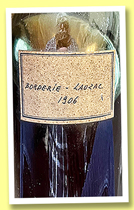
|
Lauzac 1906 ‘Borderie’ (37.3%) 
This one came with a charming little handwritten label, possibly a private bottling, or perhaps the original label was lost or replaced by this artisanal substitute. The ABV reflects the cognac's strength at the time of opening, measured using our friend Angus’s trusty Anton Parr electronic alco-meter, after he uncovered this Borderies gem. That said, the name ‘Lauzac’ offers no clues about any known location or cognac house, though there is a Château Lauzac in Bordeaux. Perhaps this is an old brandy de Bordeaux, with “borderie” referring, in French, to a small farm rather than Cognac’s famous cru. A real mystery! Colour: brownish amber. Nose: not very powerful, but honey and old raisins emerge, like those found in a tin box tucked away for decades. This develops into sweet wine notes, reminiscent of old malmsey Madeira, fruit pudding, and inevitably, Christmas cake. O Tannenbaum, O Tannenbaum, wie treu... It’s all wonderfully old-school, with a touch of sticky Jerez brandy about it. Mouth: that’s spot on—honey, pancake syrup, heaps of raisins, and lush dessert wines (think Tokaji, Rivesaltes, Pineau…). Then come delightful hints of aromatic herbs, aniseed, and pipe tobacco. It may feel slightly “doctored” but doesn’t veer into coffee liqueur territory. Finish: fairly long, almost sticky with sugary sweetness, though the herbs keep it afloat beautifully. Comments: a rather luscious old cognac (or brandy) that brings to mind the style beloved by my dearly missed grandparents. I’m thinking of them as I savour the last drops of this charming ‘Lauzac’.
SGP:650 - 89 points. |
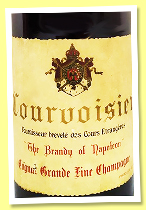
|
Courvoisier 60 yo ‘The Brandy of Napoléon’ (Grande Fine Champagne, late 1930s) 
The “60 ans” is indicated on the first label, while the second states “by appointment to the late King George V”, who passed in 1936. Likely bottled in the late 1930s then, this would include distillates from the 1860s–1870s, around the time phylloxera began ravaging the Charente vineyards (mainly planted with folle blanche) in 1872. While folle blanche now accounts for just 1% of the region’s vines, it’s enjoying renewed focus in some cuvées, and this venerable Courvoisier is likely mostly, if not entirely, folle blanche. Let’s dive in! Colour: walnut stain. Nose: we rarely taste these major brands—perhaps not malternative enough for this humble site—but I recall trying the full Erté Collection, all around 60 years old, with vintages going down to 1892. Some were excellent; might this even older 60-year-old be in the same league? Its deep, almost opaque colour signals a decidedly ‘retro’ style, to say the least. The nose is unique, rich with chestnut cream, milk chocolate, hazelnut spread (from a famous brand), Corinth raisins, umeshu, mocha, and pipe tobacco. There’s a touch of morels and earthy humus typical of ancient bottles, yet it’s not at all mouldy—on the contrary, it’s rather majestic (though we wouldn’t quite call it imperial). Mouth: the “Brandy of Napoléon” tagline doesn’t imply distillates from the early 19th century (or the famous comet year of 1811), but perhaps some from the Second Empire (1852–1870) could be present. It's the brand's tagline anyway. After the glorious nose, the palate feels more liqueur-like, as these old cognacs often do, lacking the definition of finer WF stalwarts. Loads of raisins and sweet wines with a pronounced “brandy” character, but hardly any fresh fruit or spices. It’s nearly a slightly sugar-stripped liqueur with notes of pine buds, coffee, chocolate, fig, and honey liqueurs. Some Cognac houses do make such honey-based liqueurs (Normandin comes to mind), as do whisky distilleries (Jack, Irish Mist, Drambuie, Bushmills, Atholl Brose, etc.). Finish: medium length, sweet, leaning on raisins, dessert wines (moscatel), and dark, slightly tannic honey. Comments: rather at the top of the range for this charmingly antique, elegantly old-fashioned style.
SGP:631 - 88 points. |
(Merci, Monsieur Angus !) |
|
|
| |
|
|
|
|
|
|

